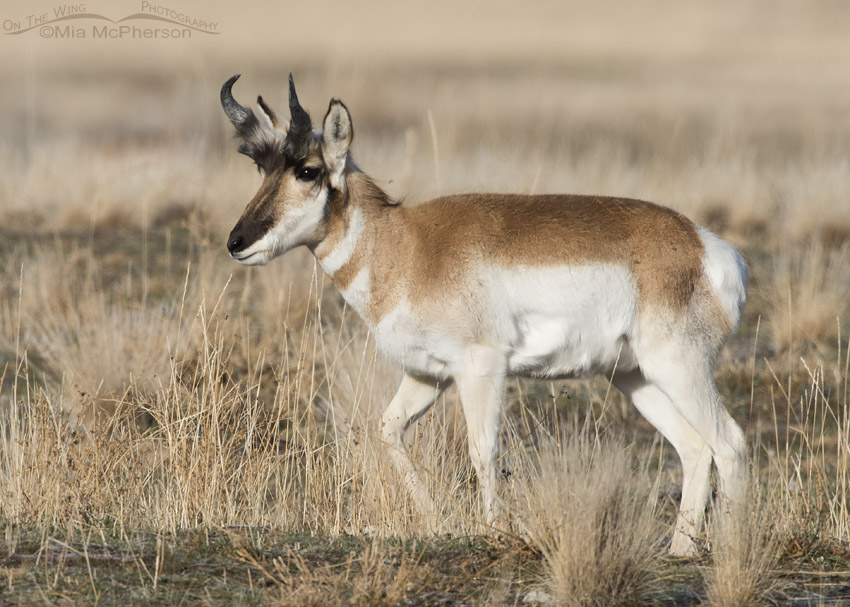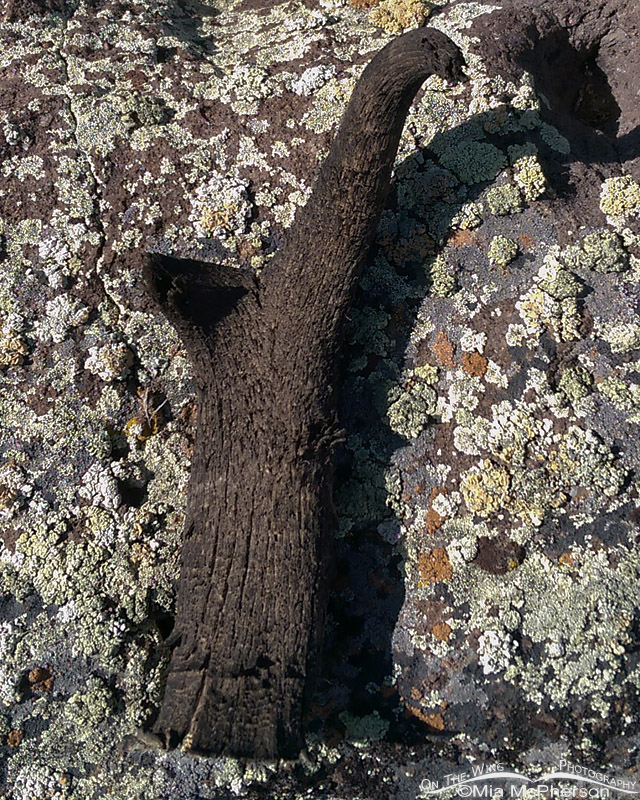Pronghorns’ unique horns shed the sheath yearly, making their horn sheath growth an interesting subject as they are the only ungulate with this characteristic.
 Pronghorn buck during horn sheath growth – Nikon D810, f6.3, 1/2000, ISO 500, Nikkor 500mm VR with 1.4x TC, natural light
Pronghorn buck during horn sheath growth – Nikon D810, f6.3, 1/2000, ISO 500, Nikkor 500mm VR with 1.4x TC, natural light
Their horns are different from the typical horns on ungulates, say for instance the horns on a Bighorn Sheep which continue to grow throughout the life of the sheep, do not have forks and are never shed. Their horns are also different from the antlers of members of the deer family who shed their antlers yearly after the end of rut and they are nearly always forked.
Antlers are made of bone while horns are hollow and composed of keratin, the same as our fingernails.
Pronghorn have different headgear. Each horn is composed of a slender, flattened blade of bone that grows from the front of the skull, that bone forms the permanent core of the horn.
The image above shows a mature Pronghorn buck last December on Antelope Island State Park after he had shed the outer sheath of his horns which we can compare to the third image below of a mature buck during the rut. The horns of the buck above don’t have a fully developed sheath.
 Shed horn sheath of a Pronghorn – HTC One M8, f2, 1/3932, ISO 125, 4mm, natural light
Shed horn sheath of a Pronghorn – HTC One M8, f2, 1/3932, ISO 125, 4mm, natural light
The sheath that covers the bony core is a keratinous sheath which is shed and regrown on an annual basis. This past March while I was camping in Wayne County, Utah I found a shed horn sheath at the campsite and photographed it with with my phone. The specimen I found had weathered and almost looked like tree bark. The sheath is hollow and didn’t weigh very much at all, in fact I was surprised by how light it was. The annual new growth of the pronghorn horn sheath actually aids in pushing the old horn sheath off as it grows.
 Pronghorn close up – Nikon D200, f7.1, 1/1000, ISO 400, Nikkor 200-400mm VR with 1.4x TC at 200mm, natural light
Pronghorn close up – Nikon D200, f7.1, 1/1000, ISO 400, Nikkor 200-400mm VR with 1.4x TC at 200mm, natural light
The image above of a mature pronghorn buck was taken during the month of September on Antelope Island State Park during the pronghorn rut, it shows the forward facing single flat prong that is also called the cutter which is not evident in the first image. The horn of this buck has a fully developed sheath. I have never found a shed horn sheath on Antelope Island but I am pretty sure they are there.
I did not keep the shed horn sheath I found in Wayne County because I am not informed about laws concerning shed horn sheaths. Besides it belongs on the windswept sagebrush steppe I found it on.
Pronghorn are the sole living species in its genus Antilocapridae and they are only found in North America so they are as unique as their horns.
Life is good.
Mia
Click here to see more of my Pronghorn photos plus facts and information about this species.


Just revisited theses images…to look at the lichens once again….they ate so beautiful…like snowflakes in their uniqueness or jewels in their beauty…
It is just after six in the morning – and I have already learnt several new things for the day. And gazed at beauty.
Thank you.
Nice images and informative post. Got me thinking about the extinct cat that used to hunt them. Today they are preyed upon by bears, wolves, cougars, coyotes and even bald eagles says science writer Brian Switek in a wired.com essay. A wonderful animal that I hope is around for many generations to come.
Wow, I love pronghorn antelope. This was very interesting–did not know that about their horns. Your photos are great illustrations. Thanks!
Thanks! Learned something new and it’s not even 8AM!
Always exquisite images and informative. The lichen and horn would easily pass for a branch as you said. Thanks Mia!
Thanks for a very interesting, informative posting…I knew almost none of what you told us. I used to wonder what became of antler sheds, then learned they were a valuable source of calcium and other minerals for the small animals that chewed them up, which is why we don’t find that many. I knew my squirrel like to chew on bones and antler sheds. I wonder what happens to the prongs’ shed horn sheaths.
I always enjoy and learn so much about the birds, wildlife and locations you photograph and post in your wonderful daily blog, Mia. As a photographer, I also appreciate that you share shooting details.
Beautiful images, Mia. Love learning about these Animals.
Very informative Mia! This is my favourite N. American mammal and I love learning more about them. Thank you for sharing. Glen